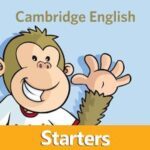Practica para tu examen B1
El examen B1 se enfoca en temas prácticos y relevantes para la vida diaria, como la educación, el trabajo, la salud, el transporte y el ocio. Los estudiantes deben ser capaces de entender conversaciones y mensajes relacionados con estos temas, y de comunicarse con fluidez y precisión en situaciones sociales y profesionales. También deben ser capaces de producir textos claros y coherentes sobre temas cotidianos, y de expresar opiniones y justificarlas en detalle.
El examen B1 es un nivel intermedio en el Marco Común Europeo de Referencia para las Lenguas (MCER) y se considera un nivel de umbral para la competencia lingüística independiente. Los estudiantes que pasan el examen B1 demuestran que tienen las habilidades lingüísticas necesarias para comunicarse efectivamente en una amplia variedad de situaciones cotidianas y profesionales, y que están preparados para continuar su aprendizaje del idioma a niveles más avanzados
#1. Which of the following words is an adjective?
Answer: Happy. Justification: «Happy» describes the quality of something or someone.
#2. Which tense is used to talk about actions happening at the moment?
Answer: Present continuous. Justification: Present continuous describes actions in progress in the present moment.
#3. Which of the following is a conjunction?
Answer: And. Justification: «And» is a conjunction that connects two or more words, phrases, or clauses.
#4. Which of the following is a preposition?
Answer: In. Justification: «In» is a preposition that shows the relationship between two nouns, indicating their location in time or space.
#5. Which of the following is a superlative adjective?
Answer: Biggest. Justification: «Biggest» is a superlative adjective used to describe something that is the highest or greatest in degree.
#6. Which of the following modal verbs is used to express possibility?
Answer: Can. Justification: «Can» is a modal verb used to express ability, permission, or possibility.
(adsbygoogle = window.adsbygoogle || []).push({});
#7. Which of the following is an adverb of frequency?
Answer: Sometimes. Justification: «Sometimes» describes the frequency of an action.
#8. Which of the following is a phrasal verb?
Answer: Put up with. Justification: «Put up with» is a phrasal verb that means to tolerate or endure something.
#9. Which of the following is a comparative adjective?
Answer: Bigger. Justification: «Bigger» is a comparative adjective used to compare two things or people.
#10. Which of the following is an irregular verb in the past tense?
Answer: Went. Justification: «Went» is the past tense of the irregular verb «go».
#11. Which of the following is a countable noun?
Answer: Book. Justification: «Book» is a countable noun because it can be counted as one, two, three, etc
#12. Which of the following is a determiner?
Answer: The. Justification: «The» is a determiner used to specify a particular noun.
#13. Which of the following modal verbs is used to make a suggestion?
Answer: Should. Justification: «Should» is a modal verb used to give advice or make a suggestion.
#14. Which of the following verb tenses is used to talk about a completed action in the past?
Answer: Past simple. Justification: The past simple tense is used to talk about a completed action in the past.
#15. Which of the following is a preposition of place?
Answer: In. Justification: «In» is a preposition of place used to describe something that is located inside a place or container.
#16. Which of the following is a pronoun?
Answer: She. Justification: «She» is a pronoun used to refer to a female person or animal.
#17. Which of the following is a conjunction?
Answer: And. Justification: «And» is a conjunction used to join words, phrases, or sentences.
#18. Which of the following modal verbs is used to express possibility or uncertainty?
Answer: Might. Justification: «Might» is a modal verb used to express possibility or uncertainty about a present or future situation.
#19. Which of the following is a past participle?
Answer: Eaten. Justification: «Eaten» is a past participle used in the present perfect tense, which is formed by combining «have/has» with the past participle of the verb.







No logre pasar pero esta muy bueno el test para practicar mis habilidades